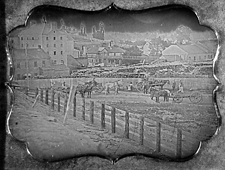Allan's Mill facts for kids

View from Allan's Mill, 1855
|
|
| Location | Guelph, Ontario, Canada |
|---|---|
| Owner | Horace Perry |
| Further ownership |
|
| Construction | |
| Built | 1830 (wooden mill) |
| Renovated |
|
Allan's Mill was an important old mill located on both sides of the Speed River in Guelph, Ontario, Canada. A mill uses the power of flowing water to turn machinery, often for grinding grain. Today, part of the land where the mill once stood is protected under the Ontario Heritage Act.
Contents
The Story of Allan's Mill
Allan's Mill was the very first industrial building in Guelph. It was first built in 1830 by Horace Perry. This first mill was made of wood and sat on the west side of the Speed River.
How the Mill Grew
In 1832, William Allan bought the mill. He used it to grind grain into flour. By 1836, the mill complex had grown much larger. It now included buildings on both sides of the river. These new parts included a place that made spirits, a brewery, and a wool processing house. William Allan and his son David ran these businesses together.
Around 1850, the original wooden mill was taken down. A new, stronger mill was built from limestone. A bridge was also added across the river. This bridge connected the two halves of the mill complex. Old records say the new stone mill had round towers, like buildings in Scotland. The building that made spirits sold many products. Around 1877, the Allan family sold the mill to David Spence. It kept grinding flour until several fires badly damaged the building.
What Happened to the Mill Site?
After the mill stopped working, the land became home to other businesses.
West Bank Developments
The west side of the river later housed several companies. The Flexible Conduit Company, which later became Dalyte Electric Co., was there from 1909 to 1929. In the 1960s, a feed and seed business and a plastics company used the site. However, fires destroyed these buildings in 1966. Today, the stone ruins of the old mill are part of Guelph's Heritage Park.
East Bank Developments
On the east side of the river, the building that once made spirits became home to many different companies. First, the McCrae Woollen Company used it until 1900. Then, the A.R. Woodyatt foundry bought the site. This company later became Taylor-Forbes. Taylor-Forbes stayed there until 1955.
After that, the W. C. Wood Company bought the site. They used it to make appliances until 2010.
Modern Use of the Site
After the W. C. Wood factory closed, the land was cleaned up. In 2014, construction began on The Metalworks. This is a new apartment complex. In 2019, as part of The Metalworks project, the Spring Mill Distillery opened. It is in the same building that was built for the Allan Distillery almost 200 years ago.
Images for kids


